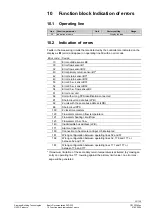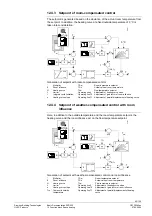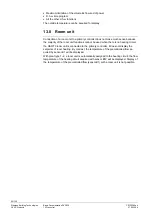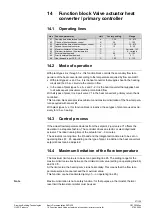
47/130
Siemens Building Technologies
Basic Documentation RVD230
CE1P2383en
HVAC Products
12 Function block Space heating
27.05.2004
duces an instant parallel displacement of the heating curve. The correlation between
the amount of the deviation and the extent of the displacement is defined by the room
influence. This is dependent on the
•
set room authority
•
deviation of the actual room temperature from the setpoint
•
set heating curve slope
These 3 factors are used to generate the correcting variable for the flow temperature
setpoint.
Main application of this type of control are well insulated buildings or buildings with
considerable heat gains where
•
several rooms are occupied at the same time
•
one of the rooms is suited as a reference room for the room temperature
12.6 Automatic ECO function
12.6.1 Fundamentals
The automatic ECO function is active with plant types 1–x, 2–x, 3–x, 7–2 and 8–4. It
controls the heating system depending on demand. This function gives consideration to
the development of the room temperature depending on the type of building construc-
tion and as a function of the outside temperature. If the amount of heat stored in the
house or building is sufficient to maintain the room temperature setpoint currently re-
quired, the ECO function will switch the heating off (valve fully closed, heating circuit
pump off).
Action of the automatic ECO function means:
•
Heating circuit pump OFF; it can only be activated by frost protection for the plant
•
Heating circuit mixing valve CLOSED
In the individual operating modes, the automatic ECO function behaves as follows:
Operating mode
Automatic ECO function is …
Automatic operation
Active
Continuous operation
Inactive
Standby Active
Manual operation
Inactive
In the case of the RVD230, the automatic ECO function performs 2 part functions. ECO
function 1 is used primarily in the summer, ECO function 2 responds mainly to short-
term temperature changes and, therefore, is active during intermediate seasons.
When using the automatic ECO function, the heating system operates only or con-
sumes energy only if needed.
If required, the automatic ECO function can be deactivated.
12.6.2 Compensating variables and auxiliary variables
Refer to section 12.2 "Compensating variables"
The automatic ECO function requires an outside sensor. As a compensating and auxil-
iary variable, the ECO function takes into account the progression of the outside tem-
perature. The following variables are taken into consideration:
•
The actual outside temperature (T
A
)
•
The attenuated outside temperature. Compared to the actual outside temperature, the
attenuated outside temperature is significantly damped. This ensures that no heating
will take place in the summer when, under normal circumstances, the heating would be
switched on because the outside temperature drops for a few days
•
The composite outside temperature (T
AM
). Since the composite outside temperature is
attenuated compared to the actual outside temperature, it represents the effects of
Note
















































